CS 502: Computing Methods for Digital Libraries - PowerPoint PPT Presentation
Title:
CS 502: Computing Methods for Digital Libraries
Description:
Interoperability in Heterogeneous Distributed Systems. The Computing Challenge ... Concepts are continually changing. Systems are continually changing. 11 ... – PowerPoint PPT presentation
Number of Views:38
Avg rating:3.0/5.0
Title: CS 502: Computing Methods for Digital Libraries
1
CS 502 Computing Methods for Digital Libraries
- Lecture 19
- Interoperability Z39.50
2
Administration
3
Digital Library Systems
Collections
Users
Repositories
Search Systems
Identification Systems
Services
4
Digital Library Systems Independent Collections
and Services
5
Interoperability in Heterogeneous Distributed
Systems
The Computing Challenge To build large-scale
distributed systems where The components are
managed by many different organizations
Every system is a legacy system
6
Interoperability in Heterogeneous Distributed
Systems
The Computing Challenge To build large-scale
distributed systems where The components are
managed by many different organizations
Every system is a legacy system
Every Technical Decision has an Organizational
Context
7
Dienst Broadcast Distributed Search
8
Backup index server
backup index
9
Regional Structure
central collection server
regional collection server
regional merged index server
10
Approaches to standardization
The conventional approach ? Technical leaders
develop standards protocols, formats, etc.
- Everybody implements the standards. -
This creates an integrated, distributed system.
Unfortunately ... ? Standards are expensive to
adopt. ? Concepts are continually changing. ?
Systems are continually changing.
11
Function versus cost of acceptance
Cost of acceptance
Function
12
Function versus cost of acceptanceExample text
markup
Cost of acceptance
SGML
XML
HTML
ASCII
Function
13
Function versus cost of acceptanceExample
identifiers
Cost of acceptance
URN
Domain names
URL
Function
14
Federated digital library
Definition Federated digital library. A group of
digital libraries that support common standards
and services, thus providing interoperability and
a coherent service to users. In a federation, the
partners may have different systems, but must
agree on
- technical standards (formats, protocols,
interfaces, object models, metadata, etc.) - policies (financial agreements, intellectual
property, security, privacy, etc.)
15
The Z 39.50 federation
Libraries that agree on Anglo American
Cataloging Rules MARC format Z39.50
protocol Bib1 search query A successful
federation. An important legacy system.
16
Aims of Z39.50
- Permits one computer, the client, to search and
retrieve information on another, the database
server - Important both technically and for its wide use
in library systems - Most development has concentrated on
bibliographic data - Most implementations emphasize searches that use
a bibliographic set of attributes to search
databases of MARC records
17
Sample query
In the database named "Books" find all records
for which the access point title contains the
value "evangeline" and the access point author
contains the value "longfellow."
18
Z39.50 principles
- Abstract view of database searching.
- Server stores a set of databases with searchable
indexes - Interactions are based on a session
- The client opens a connection with the server,
carries out a sequence of interactions and then
closes the connection. - During the course of the session, both the server
and the client remember the state of their
interaction.
19
State
- Z39.50
- The server carries out the search and builds a
results set - Server saves the results set.
- Subsequent message from the client can reference
the result set. - Thus the client can modify a large set by
increasingly precise requests, or can request a
presentation of any record in the set, without
searching entire database.
20
Z39.50 principles
- Client is a computer.
- End-user applications need a user interface for
communication with the user. - The protocol makes no statements about the form
of that user interface or how it connects to the
Z39.50 client.
21
Z 39.50 services
init -- client connects to the server and
exchanges initial information, e.g., preferred
message size explain -- client inquires of the
server what databases are available for
searching, the fields that are available, the
syntax and formats supported, and other
options search -- client presents a query to a
database choices of syntax for specifying
searches only Boolean queries widely
implemented one or more records may be
returned to the client
22
Z 39.50 services
manipulation of results sets -- e.g., sort or
delete present -- requests the server to send
specified records from the results set to the
client in a specified format options for
controlling content and formats
for managing large records or large results sets
23
Technical history
- Z39.50
- Developed for X.25 networks (connection
orientation), conversion to run over TCP fitted
later - Original concept in days when repeating a search
was expensive computation (about 1980) - WAIS is a stateless derivative of an early
version of Z39.50































